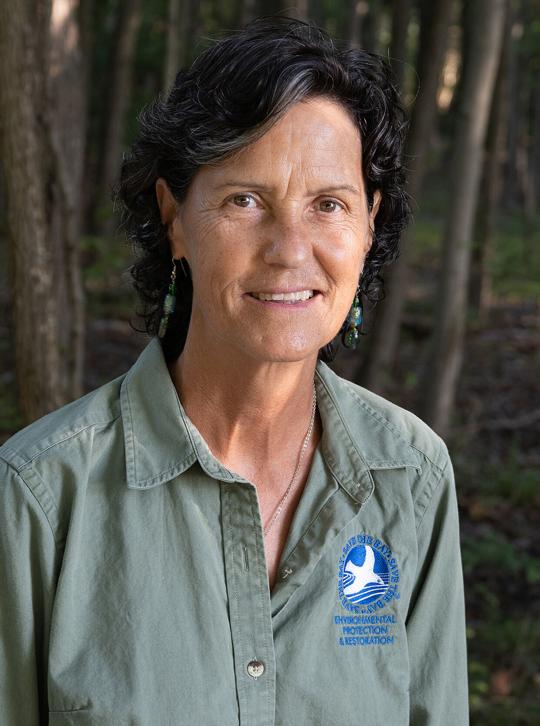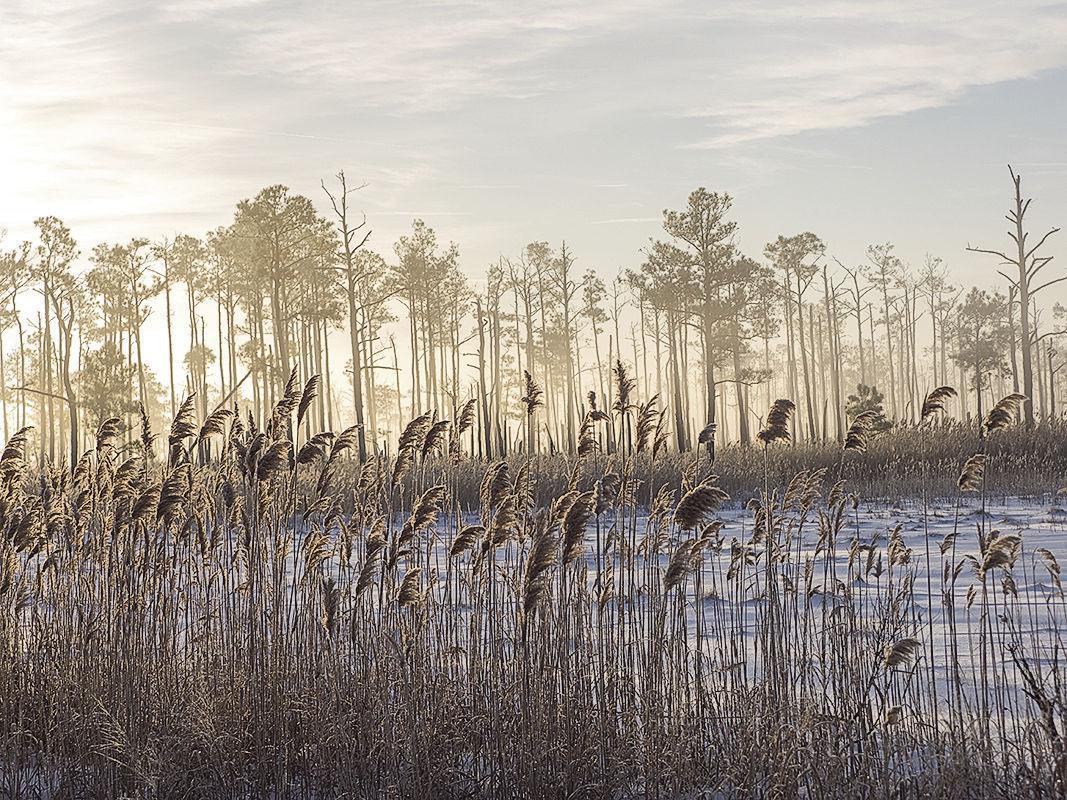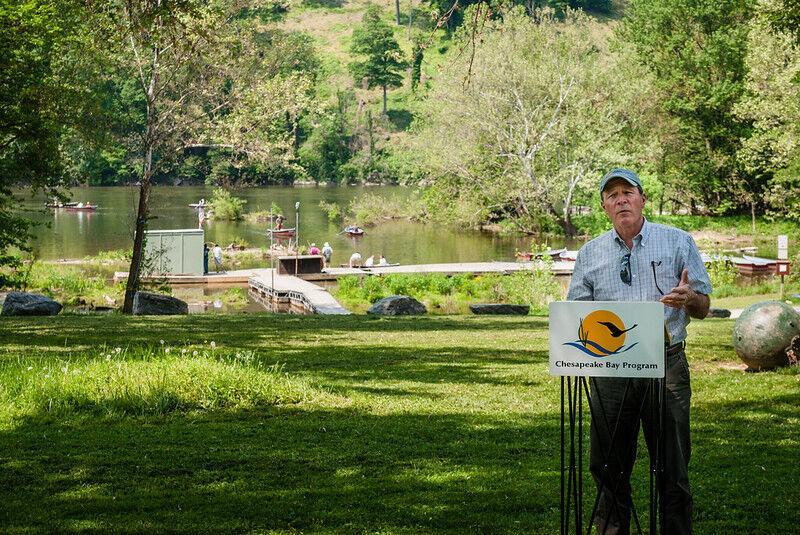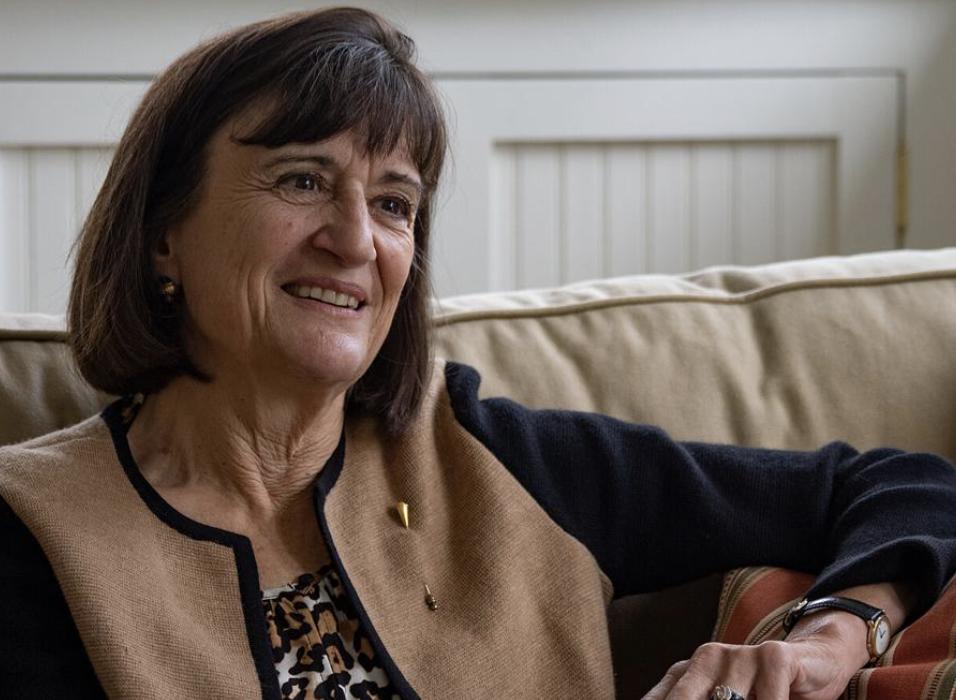
Beth McGee, senior scientist at the Chesapeake Bay Foundation, walks along a Maryland shoreline in August 2020. Photo by Dave Harp
Beth McGee, a longtime senior scientist with the Chesapeake Bay Foundation whose work is reflected in some of the most widely used reports detailing the Bay’s health and value, died June 4 after a long battle with cancer.
“The Chesapeake Bay lost a giant,” said Alison Prost, CBF vice president for Environmental Protection and Restoration.
“Few have contributed as much to the science and policy of Bay restoration as Dr. Beth McGee,” Prost said. “Her love and connection to the watershed and the Bay drove her. And her intellect never let her settle for the status quo. When Beth talked, the Bay restoration community listened and acted on her advice.”
Many people in the general public are familiar with her two decades of work at CBF, even if they do not recognize her name. She oversaw production of the organization’s State of the Bay reports, one of the most widely cited assessments of the Chesapeake’s well-being.
McGee was also a lead author of a 2014 study that established a value on the natural benefits of the Bay ($107 billion a year) and how those would grow (by another $22.5 billion annually) if cleanup goals were met — figures still widely used today.
The breadth of McGee’s work over the years encompassed everything from agriculture, fish health and nutrient trading to the Conowingo Dam, toxic contaminants and much more.
 “Beth was able to become an expert on this or that aspect of science, whether it was economics or agricultural restoration tools,” said Roy Hoagland, a retired CBF vice president who worked with McGee for years. “She had a mind that was able to understand, grasp and articulate practically any subject matter.”
“Beth was able to become an expert on this or that aspect of science, whether it was economics or agricultural restoration tools,” said Roy Hoagland, a retired CBF vice president who worked with McGee for years. “She had a mind that was able to understand, grasp and articulate practically any subject matter.”
Prior to 2010, when the region was developing its latest cleanup plan — the Chesapeake Bay total maximum daily load, which limits the amount of nutrients states can send to the Bay — McGee was instrumental in developing new approaches that would provide more accountability than previous plans.
McGee was a fixture at meetings of the state-federal Chesapeake Bay Program, and colleagues there cited her ability to synthesize complex scientific issues and recommend how that could inform the many policies related to restoration efforts.
“She did not lead with that advocacy side. She was an advocate, absolutely. But she was advocate that had a strong, strong scientific foundation,” said Rich Batiuk, the retired associate director for science with the EPA’s Bay Program Office. “I found myself, probably 99% of the time, ending up agreeing with her, even when I started that conversation thinking, ‘Let me see if I can turn about her around.’ It was usually Beth who ended up turning me around and having me understand the science implications.”
Because of her ability to translate science into potential policy solutions, she was frequently asked to make presentations to the Chesapeake Bay Commission, a panel of Bay state legislators who work to turn such advice into laws.
“Beth was, for many of us, our ‘go-to’ person,” said Ann Swanson, who recently retired as the commission’s executive director. “She was a gifted conservation policymaker with a strong science background. She was most interested in getting it right, with little need for fanfare or credit. Her wit provided well-timed humor, and all of us will remember her laugh. So many of us relied on her. So many of us will now miss her.”
Kim Coble, who hired McGee at CBF in 2003, recognized early that the scientist had a gift for communicating and tapped her to help persuade lawmakers on key legislation.
“It was fun to see somebody with her scientific skills, intellect and personality, lobby,” recalled Coble, who is now executive director of the Maryland League of Conservation Voters. “As you can imagine, she was very effective at it. I don’t think she really enjoyed it, but she was very good at it.”
McGee often took the lead in creating forums to advance knowledge of Bay issues that were not always front-and-center in the public eye.
When fish diseases were turning up everywhere, from the open waters of the Bay to headwater streams in its watershed, she led efforts to organize a workshop that for the first time brought together biologists from across the region, many of whom had never met.
She was particularly proud of the development of a nitrogen footprint calculator on CBF’s website, which helps individuals estimate their contributions to the Bay’s nutrient problems and learn how they could be reduced. A link to the calculator was always in the signature line of her emails.
In more recent years, her title expanded to encompass “agricultural policy” as she took a greater role in addressing the largest source of nutrient pollution to the Bay.
The work included addressing state and federal policies, identifying ways to better target funding and programs, trying to accurately assess nutrient contributions from the growing number of chickens in the watershed and, most recently, crafting approaches to address both climate change and nutrient runoff on the region’s farms.
That’s an evolution even McGee didn’t envision when she started working on the Bay. “If you had asked me 10 years ago whether I would have agricultural policy in my title, I would have said you were crazy,” she told an interviewer from the Peal Center for Baltimore History and Architecture in 2020. “I’m actually an aquatic toxicologist by training.”
Indeed, prior to joining CBF in 2003, she worked on chemical contaminant issues with the U.S. Fish and Wildlife Service office in Annapolis. Previously, she worked with the Maryland Department of the Environment.
McGee had a bachelor’s degree in biology from the University of Virginia, a master’s degree in ecology from the University of Delaware, and a Ph.D. in environmental science from the University of Maryland.
She was an outdoor enthusiast, kayaking the Bay, hiking the region’s trails and taking long bicycling trips both here and abroad, often organizing trips for friends and colleagues.
In 2011, she and another CBF staffer made a 1,200-mile bike trip that roughly followed the perimeter of the Bay watershed to raise funds and awareness for the Chesapeake, conducting media interviews in areas far from the estuary.
She once said, “Find your passion, make it your job, and you’ll never work another day in your life!” In her Chesapeake work, McGee found her passion, continuing to push for solutions to complex problems years after her cancer diagnosis. Indeed, no matter how difficult the issue, McGee always described herself as an “eternal optimist.”
“Not only was Beth incredibly smart, thoughtful and passionate in her work for clean water, she was also known for her kindness, affability and warmth,” said Mariah Davis, acting director of the Choose Clean Water Coalition, which represents more than 200 organizations in the watershed. “We will miss Beth and hope to honor her legacy by leaving clean rivers and streams for future generations.”
By Karl Blankenship











